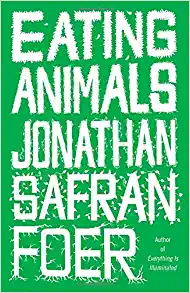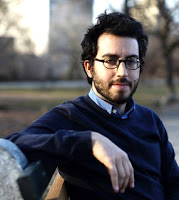by Jonathan Safran Foer
 EATING ANIMALS is a difficult book to read. It’s not just the documentation of the cruelty of modern factory farms or the quease-inducing descriptions of slaughter houses and meat processing. It’s the realization that once you know something, you have to respond. You can’t go back to unknowing. Failing to respond is a response.
EATING ANIMALS is a difficult book to read. It’s not just the documentation of the cruelty of modern factory farms or the quease-inducing descriptions of slaughter houses and meat processing. It’s the realization that once you know something, you have to respond. You can’t go back to unknowing. Failing to respond is a response.
Foer has been an intermittent vegetarian since the age of 10. But when his first child was born, he felt compelled to investigate the issue so he would know how to feed his son.
His extensive research runs the gamut from social and cultural explorations — why are we willing to eat cows or chickens but not dogs or cats — to the evolution of factory farms to interviews with farmers, food processing plant owners, former employees of the food industry and animal advocates.
The first factory farmer was Celia Steele, who managed her family’s small flock of chickens in 1923 on the Delaware-Maryland-Virginia Peninsula. When she received 500 chicks instead of the 50 chicks she ordered, she decided to see if she could keep the birds indoors through the winter.
With the help of newly discovered feed supplements, the birds survived, and Mrs. Steele continued experimenting. By 1926, she had 10,000 birds and by 1935, 250,000. (In 1930, the average flocks size in America was still only 23.)
Today, less than 100 years later, factory farms are the rule, not the exception. Foer describes poultry farms where as many as 33,000 birds are raised in sheds about 45 feet wide by 490 feet long. Less than 1% of the animals killed for meat in America come from family farms, he reports. Yet we still hold on to the image of farms as small, family-operated humane places where animals are cared for and live a mostly natural life.
The reality, according to Foer, is that many animals are raised in warehouses where light and food are artificially timed for the greatest productivity. Chickens are kept in cages stacked as many as nine high, where feces from one bird drains into the cages below. As a result, the birds are given high doses of antibiotics to help prevent infections. In addition, most poultry raised today is genetically modified to produce massive breasts, which consumers seek. Such birds would be unable to walk on their own outside of a cage.
During the slaughter and processing stage, whatever dirt and contamination is on the birds supposedly is washed off in a variety of baths, some laced with more antibiotics. Foer suggests that at the high volumes of birds being processed, much poultry is simply being steeped in contaminated fluids.
“Scientific studies and government records suggest that virtually all (upwards of 95 percent of) chickens become infected with E. coli (an indicator of fecal contamination) and between 39 and 75 percent of chickens in retail stores are still infected,” Foer writes, and then continues to discuss contamination by salmonella and campylobacter.
One particularly frightening chapter in the book dealt with avian and swine viruses, some of which are transmittable to humans. It was this type of transmission that created the 1918 influenza pandemic.
“Whereas AIDS took roughly 24 years to kill 24 million people, the Spanish flu killed as many in 24 weeks,” Foer writes. “Some recent revisions of the death toll suggest that 50 million or even as many as 100 million people were killed worldwide. Estimates suggest that one-quarter of Americans and perhaps one-quarter of the world, fell ill.”
With animals crowded together and widespread nontherapeutic use of antibiotics, Foer warns that we could be setting up a perfect storm for a new type of drug-resistant influenza virus that could equal or exceed the 1918 pandemic.
There seem to be no options for eating meat humanely raised. For example, one chapter opening has two facing pages with a rectangle about 8.75-inches by 7-inches, which Foer writes is the size of a typical cage for egg-laying hens. Then he reports that all cage-free birds have about the same amount of space. The cage maybe missing, but the birds are packed in so tightly that they hardly could be called free-ranging.
He interviewed Bill and Nicolette Niman of Bolinas, CA, who run Niman Ranch. The “ranch” is partly an actual ranch run by Nicolette as a humane alternative to factory farming. The other part of the “ranch,” run by Bill, works to build a market for humanely raised animals in the food chain. The intention is both to sustain farmers who are operating humanely and to provide consumers with an alternative. But the stumbling block typically is that once an animal has been humanely raised there are virtually no humanely operated slaughter houses or processing plants.
For Foer, the clear answer is to eat a vegetarian diet. (He doesn’t discuss much about the treatment of dairy cattle.)
He acknowledges that food and eating are complex, emotional and social. What we eat, who we eat with and why we eat what we eat are tied up with who we are. His maternal grandmother nearly starved while she was on the run from the Nazis during the Holocaust. She always made sure her children and grandchildren had plenty to eat at family gatherings and hoarded food in her older years. For her, food was love, safety and security.
Ultimately, Foer tells us, our food choices tell us who were are. He doesn’t gloss over the difficulties
— he talked about a personal tradition of going out with an old friend for sushi on a regular basis — but he does point to compromises — the option of vegetarian “sushi.”
About the Author: Jonathan Safran Foer
Jonathan Safran Foer is known primarily for his novels, the acclaimed Everything is Illuminated and Extremely Loud and Incredibly Close. His most recent novel, Here I Am, was published in 2016. He teaches creative writing at New York University.
While a freshman at Princeton University, he took an introductory writing course with author Joyce Carol Oates, who encouraged and inspired him. She served as the advisor to his senior thesis, an examination of the life of his maternal grandfather, the Holocaust survivor Louis Safran. After graduation, he briefly attended medical school and then dropped out to pursue a writing career.
His senior thesis on his grandfather became the basis for Everything is Illuminated, which earned a National Jewish Book Award in 2001 and was adapted into a film of the same name starring Elijah Wood.
His second book, published in 2005, used 9/11 as the backdrop for the story of 9-year-old Oskar Schell, who learns how to deal with the death of his father in the World Trade Center. The book earned both praise and criticism for its multiple storylines, odd and seemingly random photographs and 14-page flip book ending.
Born in Washington, D. C., his father, Albert Foer, is a lawyer and president of the American Antitrust Institute, and his mother, Esther Safran Foer, is Senior Advisor at the Sixth I Historic Synagogue. His older brother, Franklin, is a former editor of The New Republic, and his younger brother, Joshua, is the founder of Atlas Obscura.



